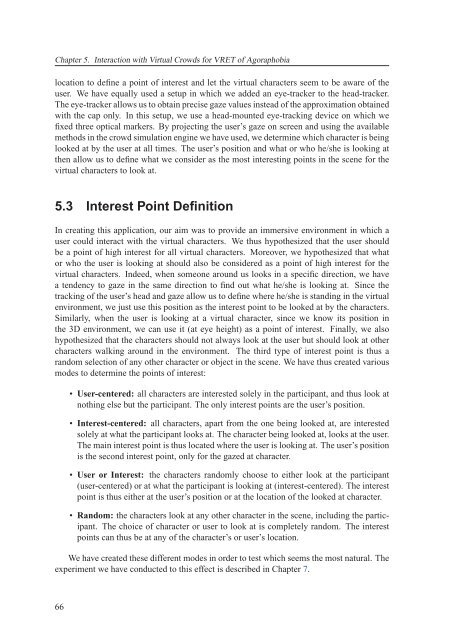Texte intégral / Full text (pdf, 20 MiB) - Infoscience - EPFL
Texte intégral / Full text (pdf, 20 MiB) - Infoscience - EPFL
Texte intégral / Full text (pdf, 20 MiB) - Infoscience - EPFL
Create successful ePaper yourself
Turn your PDF publications into a flip-book with our unique Google optimized e-Paper software.
Chapter 5. Interaction with Virtual Crowds for VRET of Agoraphobia<br />
location to define a point of interest and let the virtual characters seem to be aware of the<br />
user. We have equally used a setup in which we added an eye-tracker to the head-tracker.<br />
The eye-tracker allows us to obtain precise gaze values instead of the approximation obtained<br />
with the cap only. In this setup, we use a head-mounted eye-tracking device on which we<br />
fixed three optical markers. By projecting the user’s gaze on screen and using the available<br />
methods in the crowd simulation engine we have used, we determine which character is being<br />
looked at by the user at all times. The user’s position and what or who he/she is looking at<br />
then allow us to define what we consider as the most interesting points in the scene for the<br />
virtual characters to look at.<br />
5.3 Interest Point Definition<br />
In creating this application, our aim was to provide an immersive environment in which a<br />
user could interact with the virtual characters. We thus hypothesized that the user should<br />
be a point of high interest for all virtual characters. Moreover, we hypothesized that what<br />
or who the user is looking at should also be considered as a point of high interest for the<br />
virtual characters. Indeed, when someone around us looks in a specific direction, we have<br />
a tendency to gaze in the same direction to find out what he/she is looking at. Since the<br />
tracking of the user’s head and gaze allow us to define where he/she is standing in the virtual<br />
environment, we just use this position as the interest point to be looked at by the characters.<br />
Similarly, when the user is looking at a virtual character, since we know its position in<br />
the 3D environment, we can use it (at eye height) as a point of interest. Finally, we also<br />
hypothesized that the characters should not always look at the user but should look at other<br />
characters walking around in the environment. The third type of interest point is thus a<br />
random selection of any other character or object in the scene. We have thus created various<br />
modes to determine the points of interest:<br />
User-centered: all characters are interested solely in the participant, and thus look at<br />
nothing else but the participant. The only interest points are the user’s position.<br />
Interest-centered: all characters, apart from the one being looked at, are interested<br />
solely at what the participant looks at. The character being looked at, looks at the user.<br />
The main interest point is thus located where the user is looking at. The user’s position<br />
is the second interest point, only for the gazed at character.<br />
User or Interest: the characters randomly choose to either look at the participant<br />
(user-centered) or at what the participant is looking at (interest-centered). The interest<br />
point is thus either at the user’s position or at the location of the looked at character.<br />
Random: the characters look at any other character in the scene, including the participant.<br />
The choice of character or user to look at is completely random. The interest<br />
points can thus be at any of the character’s or user’s location.<br />
We have created these different modes in order to test which seems the most natural. The<br />
experiment we have conducted to this effect is described in Chapter 7.<br />
66

















